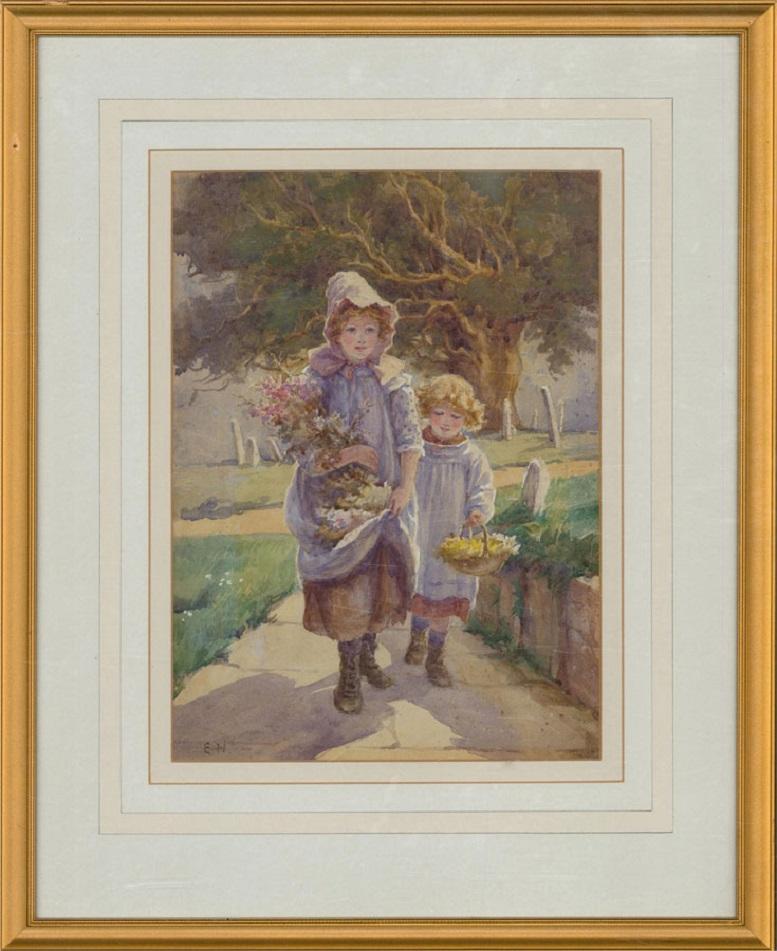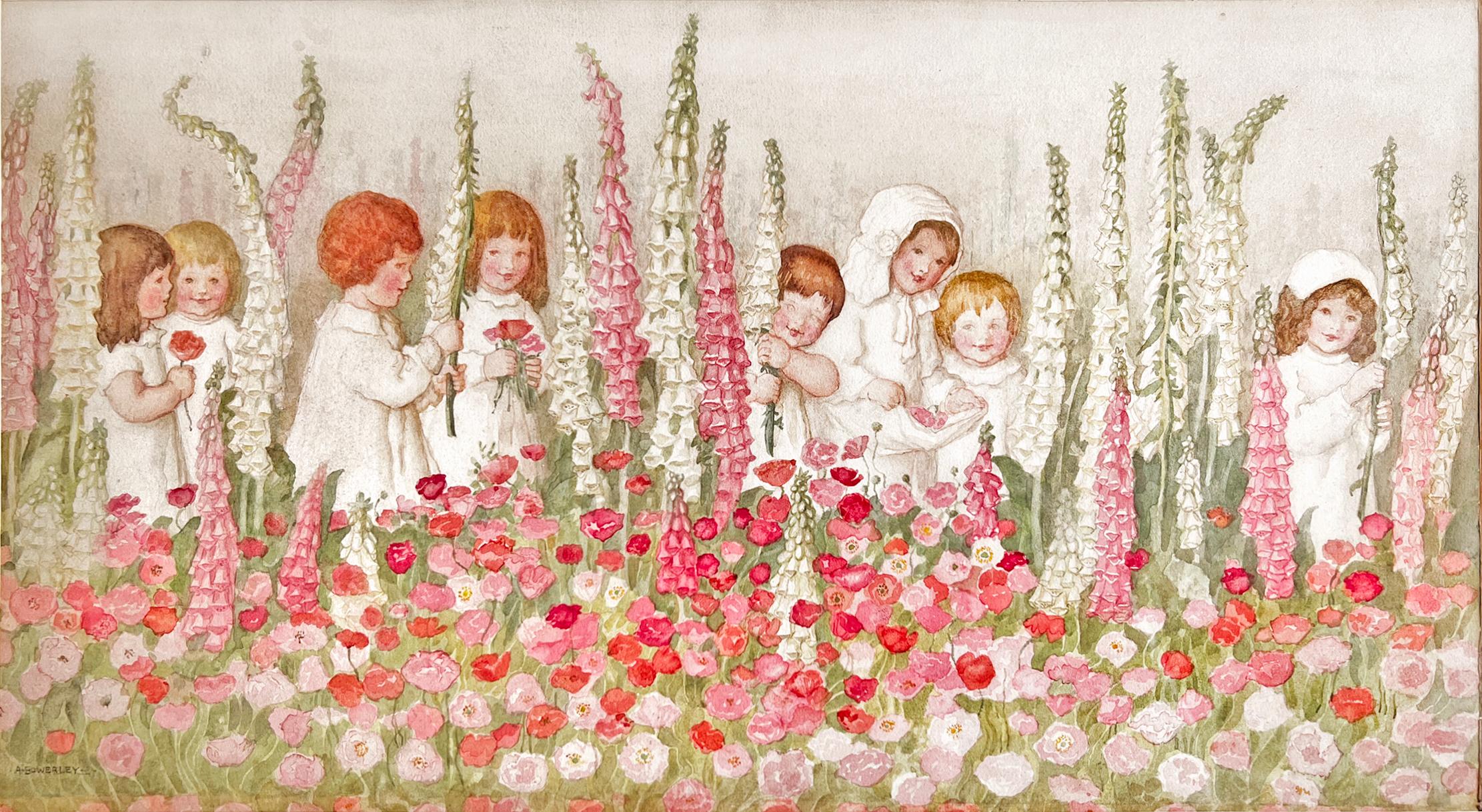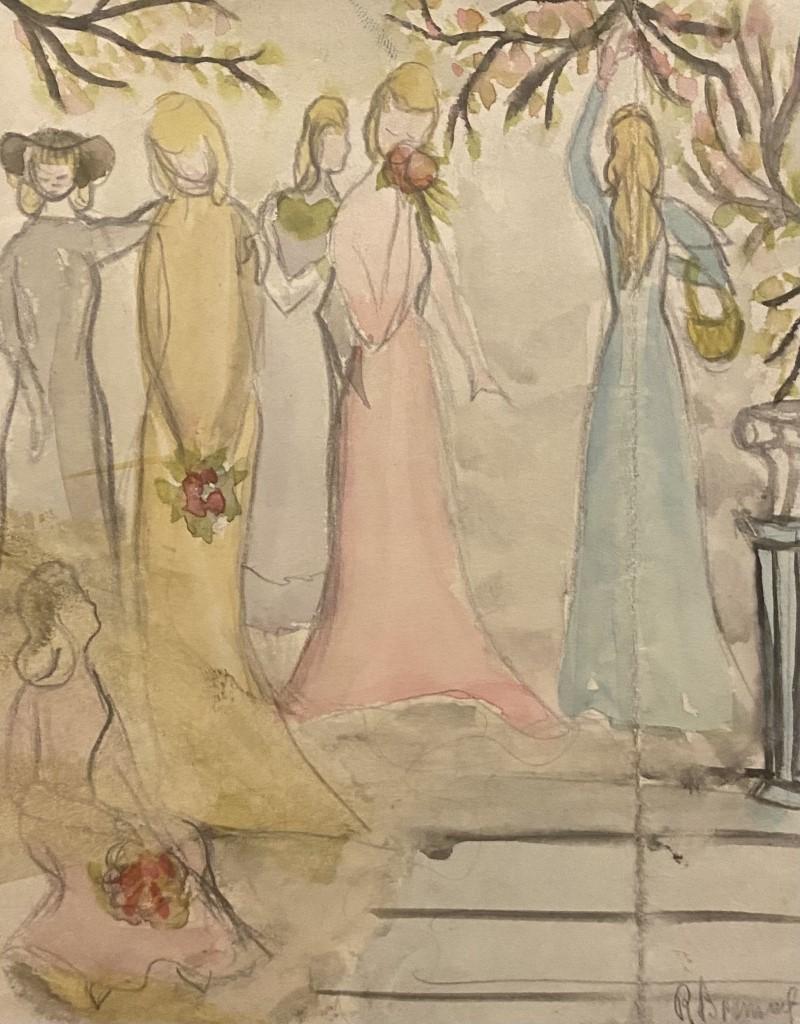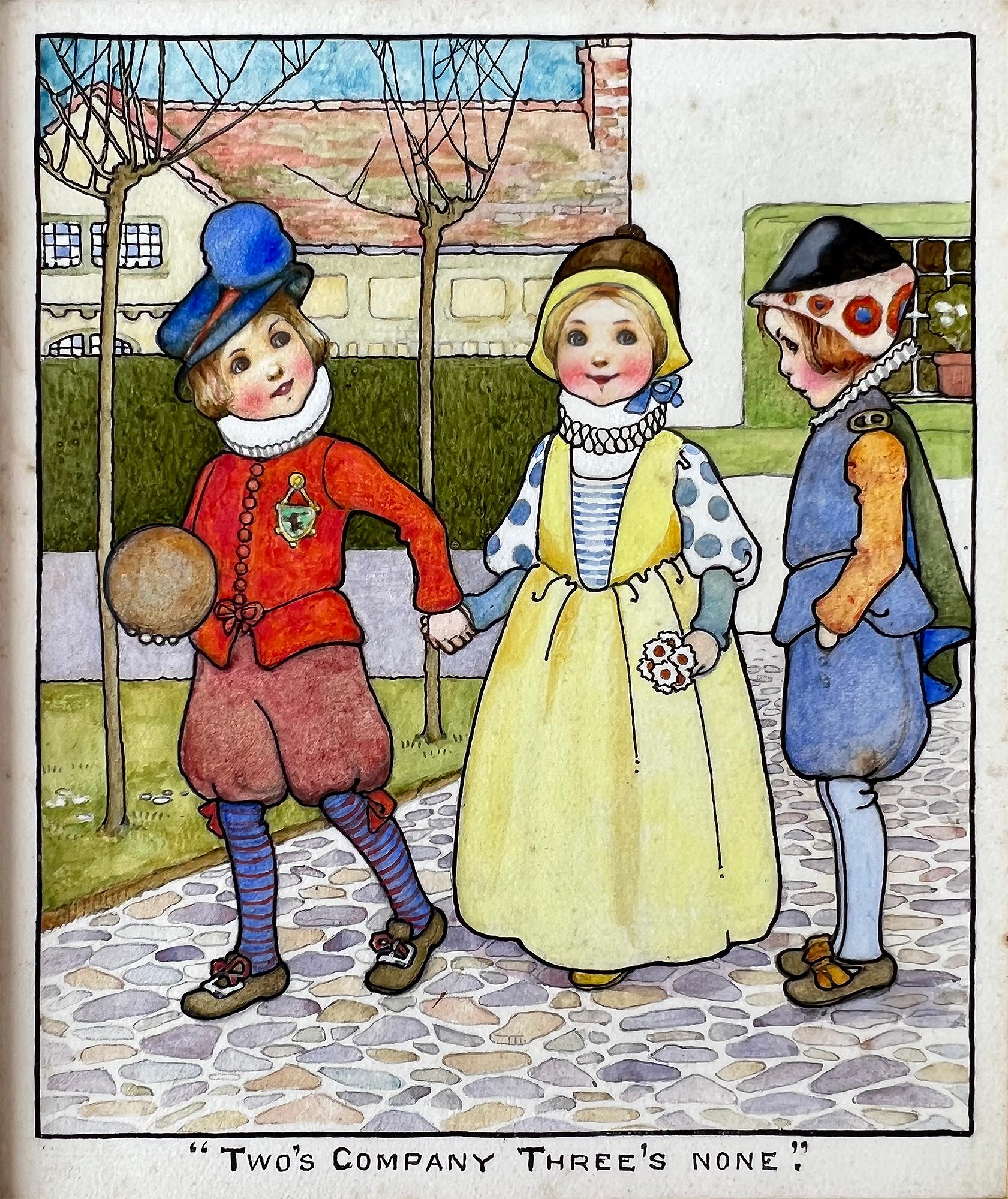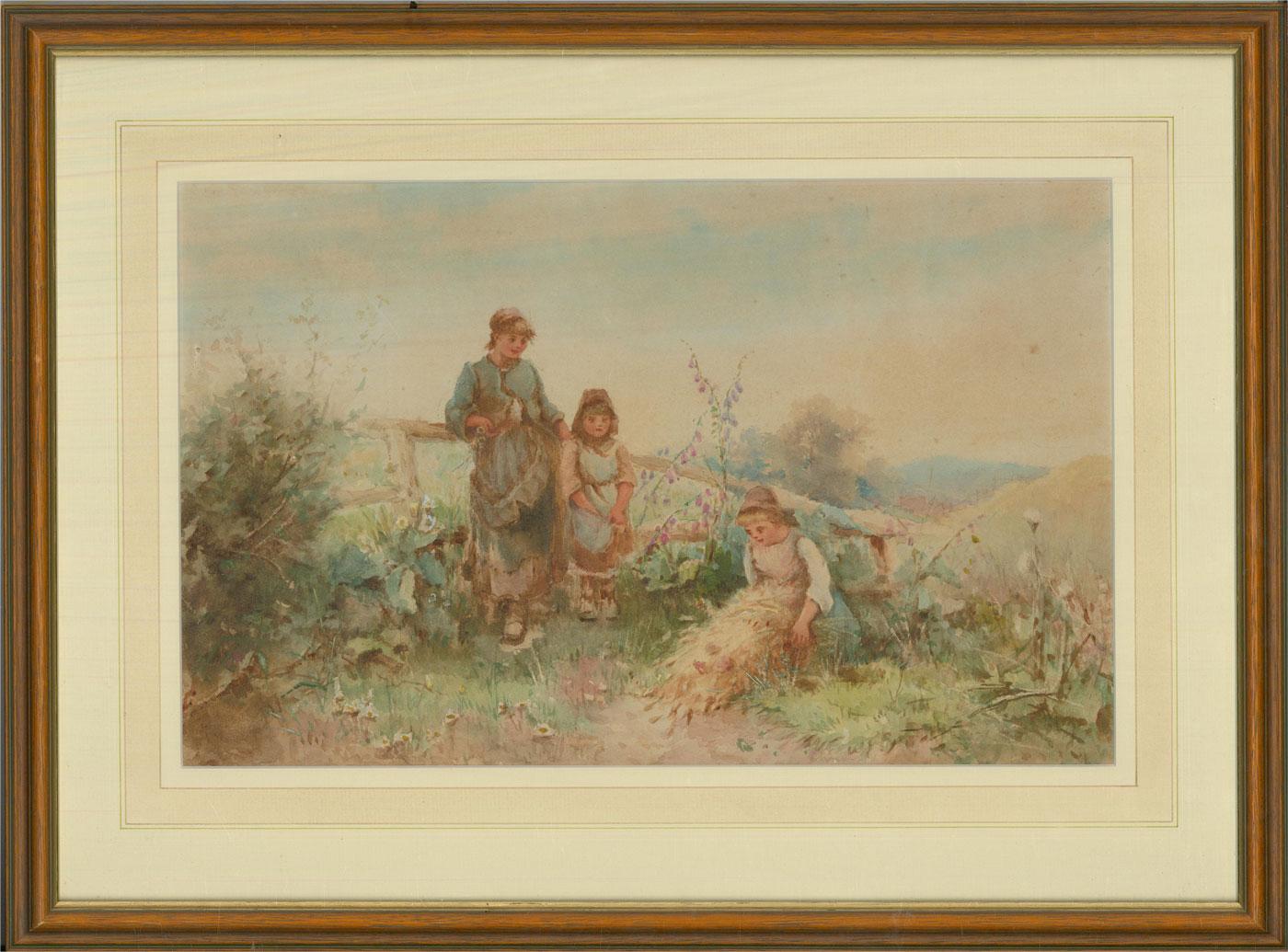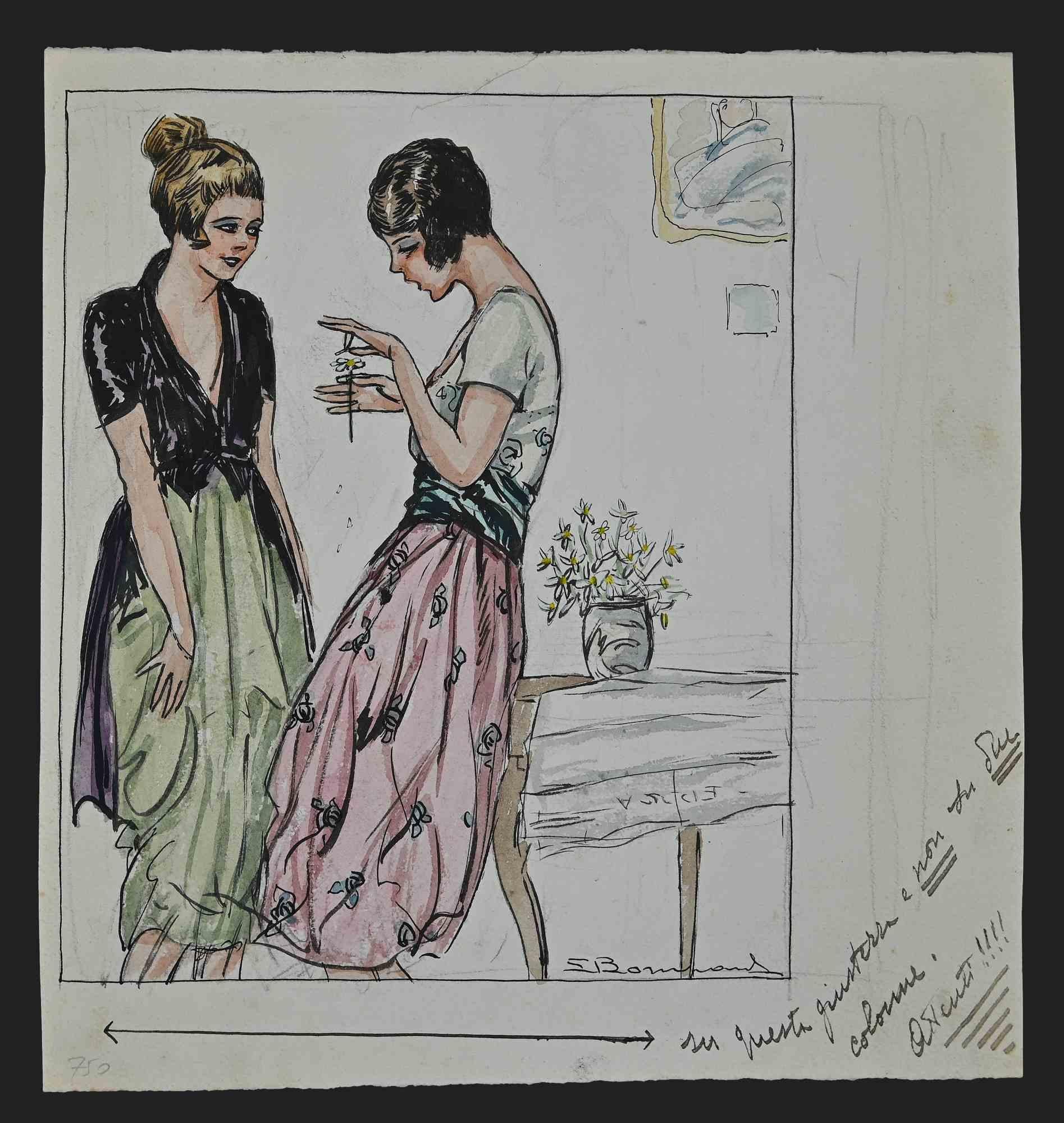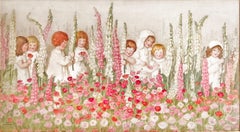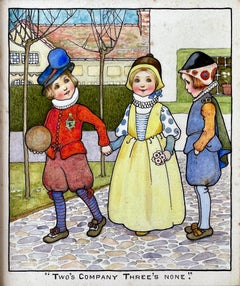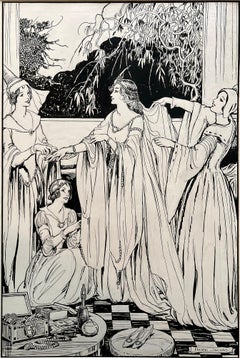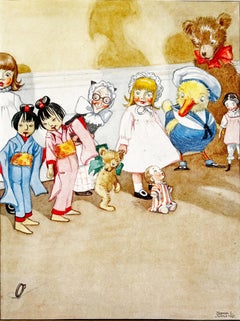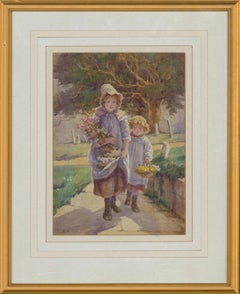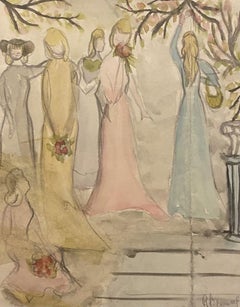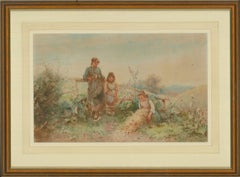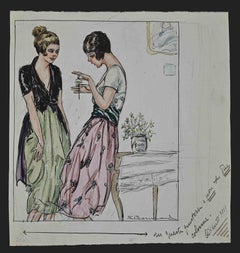Items Similar to Procession Four girls with flowers - English Female Illustrator
Want more images or videos?
Request additional images or videos from the seller
1 of 8
kate GreenawayProcession Four girls with flowers - English Female Illustrator1890
1890
$12,500
£9,556.92
€11,007.64
CA$17,516.33
A$19,555.34
CHF 10,246.70
MX$239,376.53
NOK 130,133.23
SEK 122,699.12
DKK 82,151.12
About the Item
Four young English girls with flowers are shown in a line and moving from left to right. They are pushed forward on the picture plane as if they were on a stage with a simple indication of a horizon line dottee with more flowers. monogrammed 'KG' (lower left) Matted but not framed.
From Wikipedia, the free encyclopedia
Kate Greenaway
Born Catherine Greenaway
17 March 1846
Hoxton, Middlesex, England
Died 6 November 1901 (aged 55)
Frognal, London, England
Nationality British
Education Heatherley School of Fine Art
Known for Creation of picture books
Catherine Greenaway (17 March 1846 – 6 November 1901) was an English Victorian artist and writer, known for her children's book illustrations. She received her education in graphic design and art between 1858 and 1871 from the Finsbury School of Art, the South Kensington School of Art, the Heatherley School of Art, and the Slade School of Fine Art. She began her career designing for the burgeoning holiday card market, producing Christmas and Valentine's cards. In 1879 wood-block engraver and printer, Edmund Evans, printed Under the Window, an instant best-seller, which established her reputation. Her collaboration with Evans continued throughout the 1880s and 1890s.
The depictions of children in imaginary 18th-century costumes in a Queen Anne style were extremely popular in England and internationally, sparking the Kate Greenaway style. Within a few years of the publication of Under the Window Greenaway's work was imitated in England, Germany, and the United States.
Childhood
Pencil drawing of John Greenaway at work, by Birket Foster
Kate Greenaway was born in Hoxton, London, the second of four children, to a working-class family. Her mother, Elizabeth, was a dress maker and her father, John, an engraver who gave up steady employment with Ebenezer Landells' engraving firm to strike out on his own. When Greenaway was very young, he accepted a commission to provide the engraved illustrations to a new edition of Charles Dickens's The Pickwick Papers, sending his young family away to relatives in the countryside to give himself solitude while producing the engravings. Kate's earliest memories are of Rolleston, Nottinghamshire, which affected her deeply. It was a place she returned to frequently in her childhood.[1][2] Children's literature scholar Humphrey Carpenter explains the period was to Greenway "crucial ... she felt it to be her real home, a country of the mind that she could always reimagine". After returning to grimy London streets Rolleston became a place to visit in her mind and constantly embellish.[2]
The publisher who commissioned John Greenaway's work went bankrupt, leaving the family without an income.[1][2] When Elizabeth Greenaway returned from Rolleston with the children, the family moved to Islington, where she opened a children's dress shop, that attracted well-to-do clients.[3] The family lived in the flat above the shop,[4] and young Kate, often left to her own devices to explore,[3] spent many hours in the enclosed courtyard garden, later writing about it in her unfinished autobiography as a place filled with "richness of colour and depth of shade."[4]
John Greenaway provided for his mother and two sisters as well as for his own family.[3] He took piecemeal engraving jobs, usually for weekly publications, such as The Illustrated London News. He frequently worked on the wood carving throughout the night in front of the fire.[1] Kate enjoyed watching him, and through his work was exposed to illustrations by John Leech, John Gilbert, and Kenny Meadows.[5]
As a young child Greenaway's parents taught her at home; later she was sent to various dame schools;[2] she was an avid reader of chapbook versions of fairy tales – her favourites were "Sleeping Beauty", "Cinderella", and "Beauty and the Beast" – as well as illustrated editions of Shakespeare, writing later that children "often don’t care a bit about the books people think they will and I think they often like grown-up books – at least I did."[2] Her father's engravings exposed her to weekly news stories, some of which were quite grisly, such as the series of his illustrations for the Illustrated London News in 1856 about murderer William Palmer.[5]
Education and early work
Greenaway at age 16
In 1857, at age 12, she began night classes at nearby Finsbury School,[2] a local branch of South Kensington School of Art participating in National Course of Art Training in the decorative arts. Night courses, open only to women, were offered in drawing, porcelain painting, wood engraving, and lithography.[6] She enrolled full-time a year later. The curriculum, devised by Henry Cole, was meant to train artisans in designing decorative wallpaper, tiles, and carpets. It emphasised strict adherence to copying geometric and botanical elements without creativity. There were of four stages of courses, which she completed in 1864[6] before going to the Royal Female School of Art.[7]
The headmaster at the Royal Female School of Art was Richard Burchett, whom Elizabeth Thompson described as a "bearded, velvet-skull-capped and cold-searching-eyed man."[6] Greenaway was quite shy and thought of herself as plain and unattractive compared to the other students. Yet she became friends with the much more popular Thompson,[6] with whom she shared a studio.[8] The two young women worked diligently in their studio to perfect their skills. At this point she was allowed to draw human figures, at first from plaster casts and then from models dressed in historical or ornamental costumes, skills she applied during the summers in Rolleston. However she was unable to fully master human anatomy;[7] frustrated that nude models were not permitted in the women's classes, she enrolled in night classes at Heatherley School of Fine Art where she met Edward Burne-Jones, Edward Poynter, and Walter Crane.[6]
Greenaway illustrated "Diamonds and Toads" for Frederick Warne & Co in 1871.
In 1871 she enrolled in the Slade School of Fine Art, where Poynter was head master.[6] Determined to break from Henry Cole's rigid curriculum, he exhorted students to become more expressive and creative, concepts alien to Greenaway whose long early years of training consisted solely of copying and work with geometric designs. She struggled at Heatherley and once again was frustrated that women were segregated from men in the life class.[6]
While she was still in school, Greenaway received commissions for children's book illustrations. The first came in 1867 for a frontispiece for Infant Amusements, setting a path towards specialization in children's books.[9] Her reputation was built on the awards she had won while completing the National Art Courses, and buttressed with early exhibitions. She exhibited a set of fairy watercolours in 1868, which she sold to W. J. Loftie, publisher of People's Magazine.[9] He set them to verse and printed them in his magazine. A year later Frederick Warne & Co purchased six illustrations for a toy book edition of "Diamonds and Toads";[10] printed by Joseph Martin Kronheim.[11] which took a year to complete.[6] In 1871 Gall & Inglis published an edition of Madame d'Aulnoy's fairy tales, which she illustrated.[10] That year she continued with her classes and earned more than 70 pounds.[6]
She was aware, that the work she produced was overly gaudy, in part because she lacked technical knowledge of the Chromoxylography process. To gain a better understanding of the colour process, she made frequent visits to the National Gallery;[12] where she studied masters such as Jan van Eyck, whose Arnolfini Portrait she especially liked.[8] At that time, she gained access to the manuscript room at the British Museum where she studied illuminated manuscripts.[13]
Freelance years
The new, popular and lucrative card market coincided with the end of Greenaway's formal training.[6] Greetings cards first appeared in the 1840s, and by the 1860s the market exploded.[14] Card maker Marcus Ward & Co hired Greenaway in 1871 on a freelance basis.[10] With its reputation for quality work, the Belfast firm was one of the pre-eminent Victorian era card printers. Her designs sold well and they said of her work that “her special talent was in the direction of costume figures and dainty colours.”[12] Her cards sold well, and early Valentines sold 25,000 copies in weeks.[15]
Under the Window
Her first book, Under the Window (1879), a collection of simple, perfectly idyllic verses about children, was a bestseller.[16]
Later years and death
The house in Frognal built for Kate Greenaway by Richard Norman Shaw
In the 1880s, the most popular designers of bookplates were Greenaway, along with Crane and Aubrey Beardsley. Their work exhibited intricate art nouveau elements with flowing vines and floral patterns.[17]
Greenaway was elected to membership of the Royal Institute of Painters in Water Colours in 1889. She exhibited her work at the Palace of Fine Arts at the 1893 World's Columbian Exposition in Chicago, Illinois.[18] She lived in an Arts and Crafts style house she commissioned from Richard Norman Shaw in Frognal, London, although she spent summers in Rolleston.
Greenaway died of breast cancer in 1901, at the age of 55.[19] She is buried in Hampstead Cemetery, London.
Style
Greenaway's paintings were reproduced by chromoxylography, by which the colours were printed from hand-engraved wood blocks by the firm of Edmund Evans.[20] Through the 1880s and 1890s, her only rivals in popularity in children's book illustration were Walter Crane and Randolph Caldecott.
"Kate Greenaway" children, all of them girls and boys too young to be put in trousers, were dressed in her own versions of late 18th century and Regency fashions: smock-frocks and skeleton suits for boys, high-waisted pinafores and dresses with mobcaps and straw bonnets for girls. The influence of children's clothes in portraits by British painter John Hoppner (1758–1810) may have provided her some inspiration. Liberty of London adapted Kate Greenaway's drawings as designs for actual children's clothes. A full generation of mothers in the liberal-minded "artistic" British circles who called themselves The Souls and embraced the Arts and Crafts movement dressed their daughters in Kate Greenaway pantaloons and bonnets in the 1880s and 1890s.[16] The style was often used by painter Maude Goodman in her depictions of children.
Legacy
The Kate Greenaway Medal, established in her honour in 1955, is awarded annually by the Chartered Institute of Library and Information Professionals in the UK to an illustrator of children's books.
- Creator:kate Greenaway (1846 - 1901, English)
- Creation Year:1890
- Dimensions:Height: 6.2 in (15.75 cm)Width: 9.25 in (23.5 cm)
- Medium:
- Movement & Style:
- Period:
- Condition:Some light toning and foxing otherwise presents well. The work looks better in person because the high-res camera picks up and emphasizes imperfections on the paper surface that are much less visible in person with the human eye.
- Gallery Location:Miami, FL
- Reference Number:1stDibs: LU385313611222
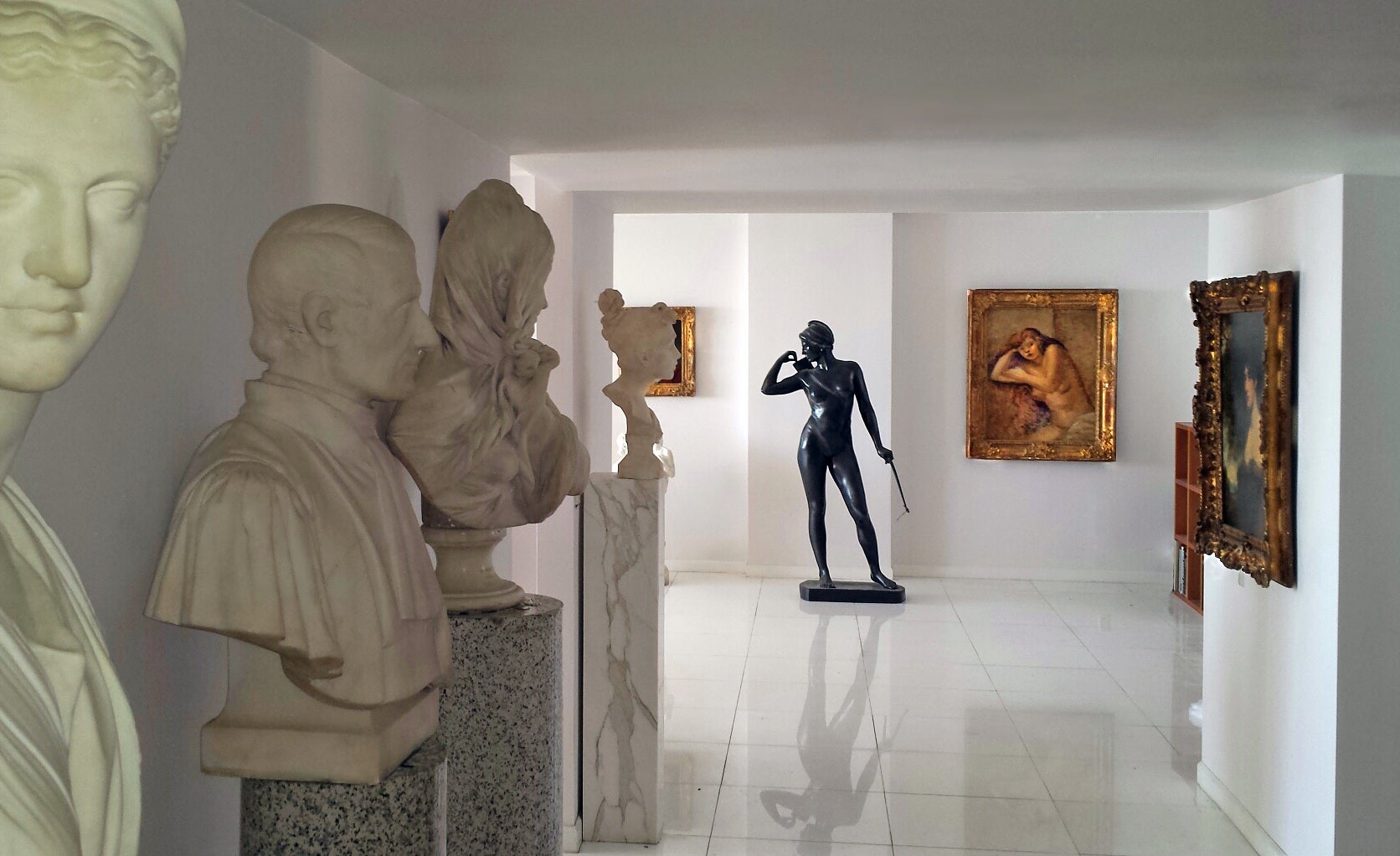
About the Seller
4.9
Gold Seller
Premium sellers maintaining a 4.3+ rating and 24-hour response times
Established in 2005
1stDibs seller since 2016
115 sales on 1stDibs
Typical response time: 1 hour
- ShippingRetrieving quote...Shipping from: Miami, FL
- Return Policy
Authenticity Guarantee
In the unlikely event there’s an issue with an item’s authenticity, contact us within 1 year for a full refund. DetailsMoney-Back Guarantee
If your item is not as described, is damaged in transit, or does not arrive, contact us within 7 days for a full refund. Details24-Hour Cancellation
You have a 24-hour grace period in which to reconsider your purchase, with no questions asked.Vetted Professional Sellers
Our world-class sellers must adhere to strict standards for service and quality, maintaining the integrity of our listings.Price-Match Guarantee
If you find that a seller listed the same item for a lower price elsewhere, we’ll match it.Trusted Global Delivery
Our best-in-class carrier network provides specialized shipping options worldwide, including custom delivery.More From This Seller
View AllChildren Amongst Foxgloves - Pink Flowers, Female Illustrator of The Golden Age
Located in Miami, FL
Children Amongst Foxgloves - Female Illustrator of The Golden Age by a female illustrator of The Golden Age Watercolor on paper, signed 'A. Bowerley' lower left.
11 x 20 in. (sight)...
Category
Early 1900s Pre-Raphaelite Figurative Drawings and Watercolors
Materials
Watercolor, Paper, Pencil
Three Children Book Illustration - Female Illustrator - Turn of the Century
Located in Miami, FL
At a certain size, painting a small painting with precise and meticulous detail becomes an art in itself. So is the case of "Three Children" by English Childen's book illustrator Amy Millicent Sowerby...
Category
Early 1900s Art Nouveau Figurative Paintings
Materials
Watercolor, Gouache
The Court Ladies Dressed Gerda - Women Illustrators
Located in Miami, FL
Women illustrators were alive, well, and quite active in the early 20th century. Most of their production was associated with topics that dealt with the home, children or fairy tales. In this masterfully rendered work in pen and ink, Jacobs displays great technical skill in presenting three maidens dressing a beautiful female member of the Court wearing a tiara. Signed in a cartouche lower right
From: Stella Mead, Great Stories from Many Lands, London: James Herbert and Co, 1936, page 78 " Red and White Roses"
Provenance: Chris Beetles
Work is elegantly matted and not framed.
Helen Mary Jacobs was born in Ilford, Essex, the sister of the writer W.W. Jacobs; she studied art at the West Ham...
Category
1930s Art Nouveau Figurative Drawings and Watercolors
Materials
Ink, Pencil
Cute Children's Book Illustration British Female Illustrator - Teddy Bears
Located in Miami, FL
A British Female Illustrator paints a warm and fuzzy scene from a child's imagination, with ducks and teddy bears gazing at a "Mr Willoughby's eyeglass" standing on it's edge as it l...
Category
1920s Victorian Figurative Drawings and Watercolors
Materials
Watercolor, Gouache
Flora Scottish Female Illustrator Glasgow Girls Pre-Raphaelites
Located in Miami, FL
Annie French was part of the Glasgow Girls group of artists and illustrators who worked in a delicate, feminine, and detailed Art Nouveau and Pre-Raphaelite style. This work, "Flora," is masterfully rendered and decorated with sumptuous floral patterns in the most detailed way. It is signed twice in the upper right quadrant. The mat has a hand-painted decorative border. The work presents better in person, and the viewer can marvel at the minute detail.
The Video is overexposed and light and not representative of color. Use still...
Category
Early 1900s Art Nouveau Figurative Drawings and Watercolors
Materials
Ink, Watercolor, Pencil
The Wise Book Children's Book Illustration- Woman Illustrator - Arts and Crafts
Located in Miami, FL
This little gem of a compact artwork was executed in the Arts and Crafts style for an interior illustration for "The Wise Book," J.M. Dent & Co, London, 1906.
"You can't eat your ca...
Category
Early 1900s Victorian Figurative Drawings and Watercolors
Materials
Ink, Watercolor, Gouache, Board
You May Also Like
Attrib. Edith Hume (1843-1906) - Watercolour, Girls and Their Flowers
Located in Corsham, GB
A fine late 19th/early 20th century watercolour attributed to the British painter and illustrator Edith Hume (1843-1906). With body colour details, depictin...
Category
20th Century Landscape Drawings and Watercolors
Materials
Watercolor
$628 Sale Price
20% Off
Girls in the Garden - Original Pencil and Watercolor - Mid-20th Century
Located in Roma, IT
Girls in the Garden is an original pencil and watercolor drawing on ivory paper by Anonymous Artist of the Mid-20th Century.
In excellent conditions...
Category
Mid-20th Century Modern Figurative Drawings and Watercolors
Materials
Pencil, Watercolor
Attrib. Fanny Mearns (fl.1870-1881) - Framed Watercolour, Girls in a Meadow
Located in Corsham, GB
A charming and delicate watercolour study attributed to the British artist Fanny Mearns (fl.1870-1881). The artist has a distinctly delicate technique, using a light palette to depic...
Category
19th Century Figurative Drawings and Watercolors
Materials
Watercolor
$301 Sale Price
20% Off
Girls with a Flower - Drawing by Luigi Bompard - 1920s
Located in Roma, IT
Girls with a Flower is a watercolor and ink drawing on ivory-colored paper, in the 1920s realized by Luigi Bompard (1879-1953).
Hand-signed in pen on the lower margin.
In good cond...
Category
1920s Art Deco Figurative Drawings and Watercolors
Materials
Ink, Watercolor
The Village Maids - British Victorian art exhibited RA 1880 watercolour painting
By Marcella M Walker
Located in London, GB
This stunning exhibited Pre-Raphaelite 19th century watercolour painting is by British Victorian female artist Marcella M Walker. The painting was painted in 1880 and exhibited at th...
Category
19th Century Pre-Raphaelite Figurative Drawings and Watercolors
Materials
Watercolor
Two Girls Playing with Flowers
By Maud Humphrey
Located in Fort Washington, PA
Signature: Signed Upper Left
Medium: Watercolor on Paper
1905 Calendar Art, a copy of the calendar is included.
Category
Early 1900s Figurative Drawings and Watercolors
Materials
Paper, Watercolor
More Ways To Browse
Childrens Clothes
Antique Paper Flowers
Flower And A Girl
Best Sellers
Girl With Flowers
Four Sisters
Girls In Windows
Victorian House Drawing
Fairy Drawing
Plaster Flower
1889 Portrait Drawing
Art Nouveau Girl
Female Nude Line Painting
Art Nouveau Library
Suit With Train
Kate Young
Nude Line Drawing Female
Skull Drawing
